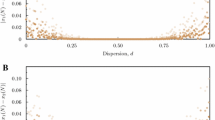Abstract.
A framework is developed for constructing a large class of discrete generation, continuous space models of evolving single species populations and finding their bifurcating patterned spatial distributions. Our models involve, in separate stages, the spatial redistribution (through movement laws) and local regulation of the population; and the fundamental properties of these events in a homogeneous environment are found. Emphasis is placed on the interaction of migrating individuals with the existing population through conspecific attraction (or repulsion), as well as on random dispersion. The nature of the competition of these two effects in a linearized scenario is clarified. The bifurcation of stationary spatially patterned population distributions is studied, with special attention given to the role played by that competition.
Similar content being viewed by others
References
Allen, E.J., Allen, L.J.S., Gilliam, X.: Dispersal and competition models for plants. J. Math. Biol. 34, 455–481 (1996)
Bascompte, J., Solé, R.V., eds.: Modeling Spatiotemporal Dynamics in Ecology. Springer-Verlag, 1997
Beverton, R.J.H., Holt, S.J.: On the dynamics of exploited fish populations. Fish Invest. Minist. Argic. Fish. Food. (London) Ser. 2, 19 (1957)
Crandall, M.G., Rabinowitz, P.H.: Bifurcation from simple eigenvalues. J. Funct. Anal. 8, 321–340 (1971)
Grimmet, G.R., Stirzaker, D.R.: Probability and Random Processes. Oxford: Oxford Science Publications, 1992
von Hardenberg, J., Meron, E., Shachak, M., Zarmi, Y.: Diversity of vegetation patterns and desertification. Phys. Rev. Lett. 87, 1998101 (2001)
Hardin, D.P., Takác, P., Webb, G.F.: A comparison of dispersal strategies for survival of spatially heterogeneous populations. SIAM J. Appl. Math. 48, 1396–1423 (1988)
Hardin, D.P., Takác, P., Webb, G.F.: Asymptotic properties of a continuous-space discrete-time population model in a random environment. J. Math. Biol. 26, 361–374 (1988)
Hardin, D.P., Takác, P., Webb, G.F.: Dispersion population models discrete in time and continuous in space. J. Math. Biol. 28, 1–20 (1990)
Hart, D.R., Gardner, R.H.: A spatial model for the spread of invading organisms subject to competition. J. Math. Biol. 35, 935–948 (1997)
Kot, M.: Discrete-time travelling waves: ecological examples. J. Math. Biol. 30, 413–436 (1992)
Kot, M., Schaffer, W.M.: Discrete-time growth-dispersal models. Math. Biosci. 80, 109–136 (1986)
Kot, M., Lewis, M.A., van den Driessche, P.: Dispersal data and the spread of invading organisms. Ecology 77 (7), 2027–2042 (1996)
Lewis, M.A., Li, B., Weinberger, H.F.: Spreading speed and linear determinacy for two-species competition models. J. Math. Biol. 45 (3), 219–233 (2002)
Lui, R.: Biological growth and spread modeled by systems of recursions. I . Mathematical theory. Math. Biosci. 93, 269–295 (1989)
Lui, R.: Biological growth and spread modeled by systems of recursions. II . Biological theory. Math. Biosci. 93, 297–312 (1989)
Matano, H., Ogiwara, T.: Stability Analysis in order-preserving systems in the presence of symmetry. Proc. Royal Soc. Edinburgh 129, 397–442 (1999)
May, R.M.: On relationships among various types of population models. Am. Nat. 107, 45–57 (1972)
May, R.M.: Biological populations obeying difference equations: stable points, stable cycles and chaos. J. Theor. Biol. 49, 511–524 (1975)
May, R.M., Oster, G.F.: Bifurcations and dynamic complexity in simple ecological models. Am. Nat. 110, 573–599 (1976)
Maynard Smith, J.: Mathematical Ideas in Biology. Cambridge: Cambridge University Press, 1968
Neubert, M.G., Kot, M., Lewis, M.A.: Dispersal and pattern formation in a discrete-time predator-prey model. Theor. Pop. Biol. 48 (1), 7–43 (1995)
Ricker, W.E.: Stock and recruitment. J. Fish. Res. Board Can. 11, 559–623 (1954)
Sanchez-Garduno, F., Maini, P.K.: A non-linear degenerate equation for direct aggregation. Unpublished manuscript
Shigesada, N., Kawasaki, K.: Biological Invasions: Theory and Practice. Oxford Series in Ecology and Evolution, Oxford: Oxford University Press, 1997
Tilman, D., Kareiva, P., eds.: Spatial Ecology. Princeton, NJ: Princeton University Press, 1997
Turchin, P.: Quantitative Analysis of Movement. Sunderland, MA: Sinauer Associates Inc., 1998
Weinberger, H.F.: Long-time behavior of a class of biological models. SIAM J. Math. Anal. 13, 353–396 (1982)
Weinberger, H.F., Lewis, M.A., Li, B.: Analysis of linear determinacy for spread in cooperative models. J. Math. Biol. 45 (3), 183–218 (2002)
Author information
Authors and Affiliations
Corresponding author
Additional information
Acknowledgement We gratefully received valuable help through discussions with Hiroshi Matano, Davar Khosnevisan, and Nacho Barradas. Khosnevisan provided us with the background information for Sections 3.3.1 and 3.3.2. Matano provided us with a proof of Lemma 4.4 similar to the one given here. Barradas drew our attention to the relation (2.1).
Rights and permissions
About this article
Cite this article
Carrillo, C., Fife, P. Spatial effects in discrete generation population models. J. Math. Biol. 50, 161–188 (2005). https://doi.org/10.1007/s00285-004-0284-4
Received:
Revised:
Published:
Issue Date:
DOI: https://doi.org/10.1007/s00285-004-0284-4




